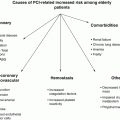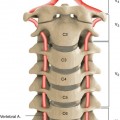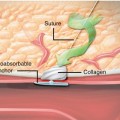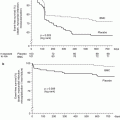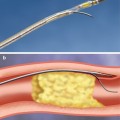PTCA group(n = 195)
tPA group(n = 200)
p value
Re-infarction or death
10(5.1 %)
24(12.0 %)
0.02
Death
5(2.6 %)
13(6.5 %)
0.06
Re-infarction
5(2.6 %)
13(6.5 %)
0.06
Recurrent ischemia
10(5.1 %)
47(23.5 %)
<0.001
These results were reinforced in the subsequent ZWOLLE trials and GUSTO-IIb angioplasty trial [7–9].
A meta-analysis of 23 randomized trials comparing primary PCI with fibrinolytic therapy demonstrated that PCI was superior to thrombolysis in reducing the incidence of short- and long-term adverse outcomes, including death [10]. Primary PCI has been shown to result in higher rates for infarct artery patency, improved coronary blood flow, and lower rates for recurrent ischemia, re-infarction, emergency repeat revascularization procedures, intracranial hemorrhage, and death when compared to thrombolysis. The survival benefit of primary PCI compared with thrombolytic therapy reported was 21 lives saved per 1,000 patients treated [10]. Early, successful PCI also greatly decreases the complications of STEMI that result from longer ischemic times or unsuccessful fibrinolytic therapy, allowing earlier hospital discharge and resumption of daily activities [11]. The greatest mortality benefit of primary PCI is in high-risk patients such as those with anterior MI, congestive heart failure (CHF), or cardiogenic shock [11, 12]. Primary PTCA outcomes may not be as successful with prolonged time to treatment or when performed either in hospitals or by operators with low PTCA volumes [13, 14].
Stents Versus Thrombolysis
Once primary PTCA became established as the preferred strategy in STEMI patients, the next question was whether PCI with a bare metal stent (BMS) was superior to thrombolysis. Despite the proven benefit of stenting compared to angioplasty in routine PCI, there was a concern that placing a stent in a fresh thrombus would be more likely to result in stent thrombosis. In a meta-analysis of 12 trials comparing primary PCI with stenting to thrombolytic therapy, primary PCI was superior to thrombolytic therapy in terms of lower overall short-term mortality (7 % vs. 9 %; p = 0.0002), nonfatal re-infarction (3 % vs. 7 %; p < 0.0001), stroke (1 % vs. 2 %; p = 0.004), and the combined end point of death, nonfatal re-infarction, and stroke (8 % vs. 14 %; p < 0.0001) [10].
Stents Versus PTCA
Both PCTA and stenting had been demonstrated to be superior to thrombolytics in the treatment of STEMI, but there remained a question of whether the benefits of less restenosis resulting from the use of stents was offset by the potential increased risk for stent thrombosis if used in a highly thrombotic milieu. The stent-PAMI trial randomized STEMI patients to PCI with either PTCA or stenting and found that stents reduced restenosis, reocclusion, and the need for target vessel revascularization compared with PTCA. Furthermore, the use of stents was not associated with an increase (or reduction) in re-infarction or mortality [9]. These findings were further confirmed in a meta-analysis of STEMI studies comparing PTCA versus stenting [10].
Bare Metal Versus Drug-Eluting Stents
Similar to the finding of decreased restenosis when stents were compared to PTCA, drug-eluting stents (DES) have also been shown to decrease restenosis rates when compared to bare metal stents (BMS) when used in patients with STEMI. Meta-analyses of several small, randomized studies comparing BMS and DES in STEMI patients revealed no differences in death, MI, or stent thrombosis rates between the two groups, but target vessel revascularization (TVR) rates were decreased with DES [15, 16]. The studies included in these meta-analyses were limited by many factors including sample size and duration of follow-up. The most robust evidence comes from the HORIZONS-AMI trial that randomized 3,006 STEMI patients to DES or BMS in a 3:1 ratio. There was no difference in the 12-month composite safety end point of death, re-infarction, stroke, or stent thrombosis. The rates of ischemia-driven target vessel revascularization and target lesion revascularization, however, were significantly lower in the DES group (5.8 % vs. 8.7 % and 4.5 % vs. 7.5 %, respectively; NNT = 33 at 1 year), as was the 13-month binary restenosis rate (10 % vs. 22.9 %) [17]. In conclusion, while there is no difference in terms of mortality, re-infarction, or stent thrombosis with the use of DES as compared to BMS in STEMI patients, there is a benefit associated with the use of DES in STEMI with a reduction in TVR and restenosis.
The Effect of Timing in PCI for STEMI (Door-to-Balloon Time)
It is now generally accepted that STEMI patients presenting to a PCI-capable facility should undergo primary PCI. Guidelines currently call for a time from arrival at the PCI-capable hospital-to-balloon inflation in the infarct-related artery (door-to-balloon or “D2B” time) of less than 90 min. This derives from the assumption that thrombolytic therapy should be able to be administered within 30 min and the fact that a primary PCI strategy may not reduce mortality when a delay of greater than 60 min is anticipated when compared with immediate administration of thrombolytics [18]. According to an analysis of 43,801 patients with STEMI undergoing primary PCI within the National Cardiovascular Data Registry (NCDR), however, any delay in time to reperfusion after arrival at the hospital was associated with a higher adjusted risk of in-hospital mortality in a continuous, nonlinear fashion (30 min = 3 %, 60 min = 3.5 %, 90 min = 4.3 %, 120 min = 5.6 %, 150 min = 7 %, 180 min = 8.4 %; p < 0.001) [19]. Consequently, rather than a goal of a 90-min D2B time for primary PCI, these data suggest that the standard should be simply as soon as possible.
PCI for Patients Presenting to Non-PCI-Capable Hospitals
Approximately 60 million people (20 % of the US population) live farther than 60 miles from a hospital capable of performing PCI [20]. It is estimated that roughly 175,000 patients per year will have a STEMI within this population and may not have access to timely PCI. According to the NCDR, only 9.9 % of patients transferred from a hospital without PCI capability for primary PCI achieve a door-to-balloon time of less than 90 min [21], and based on the NRMI data, less than 15 % of patients transferred from non-PCI facility are treated in under 2 h [22].
Transfer for PCI Versus Thrombolytics
According to the AHA/ACC guidelines, full-dose thrombolytics is the recommended reperfusion strategy for patients with expected delay [23, 24]. Unfortunately, 26–36 % of patients will ultimately fail to reperfuse and will require transfer for rescue PCI [25]. Two studies published in 2003, the Danish trial in Acute Myocardial Infarction-2 (DANAMI-2) [26] and the Primary Angioplasty in Patients transferred from General Community Hospitals to Specialized PTCA Units with or without Emergency Thrombolysis-2 (PRAGUE-2) [27], compared the outcome of thrombolysis administered immediately at a non-PCI-capable hospital versus emergent transfer for primary PCI (Table 16.2). Patients in DANAMI-2 received tPA in the thrombolytic arm, and bare metal stents were used in 93 % of patients transferred for primary PCI. Mean total door-to-balloon (from referring hospital to balloon in receiving hospital) time was 112 min for patients transferred for PCI. The rate of primary composite end point of death, re-infarction, and disabling stroke at 30 days was lower in the transferred PCI group than in the thrombolysis group (8.0 % vs. 13.7 %, p = 0.002). This was largely driven by a reduction in the rate of re-infarction (1.6 % vs. 6.3 % in the thrombolytic arm, p < 0.001), but there was a trend towards lower mortality (6.6 % in the PCI group vs. 7.8 % in thrombolysis group, p = 0.35) and disabling stroke (1.1 % in the PCI group vs. 2 % in the thrombolysis group, p = 0.15). The trial was terminated early by the Data Safety and Monitoring Board after observation of a marked improvement in the clinical outcome of patients in the group with transfer for primary PCI.
Table 16.2
DANAMI trial
Outcome at 30 days | Thrombolysis (n = 782) | Transfer for primary PCI (n = 790) | p value |
|---|---|---|---|
Death | 61(7.8 %) | 52(6.6 %) | 0.35 |
Re-infarction | 49(6.3 %) | 13(1.6 %) | <0.001 |
Disabling stroke | 16(2.0 %) | 9(1.1 %) | 0.15 |
Composite end point | 107(13.7 %) | 63(8.0 %) | <0.001 |
In PRAGUE-2, patients received streptokinase in the thrombolytic arm and bare metal stents were employed in 63 % of patients transferred for primary PCI. Mean total door-to-balloon time was 97 min. The combined end point of a 30-day incidence of death, re-infarction, and stroke was significantly lower for the transfer for PCI group as compared to thrombolysis (8.4 % vs. 15.2 %, p < 0.003). This study found a similar trend towards reduction in mortality with transfer for primary PCI (6.8 % vs. 10 %, p = 0.12). An analysis based on treatment actually received, rather than intention to treat, demonstrated a statistically significant reduction in mortality for patients who were transferred for primary PCI (6 % vs. 10.4 %, p < 0.05). In addition, the subgroup of patients presenting greater than 3 h from onset of symptoms demonstrated a clear reduction in mortality with transfer for primary PCI (6 % vs. 15.3 %, p < 0.02) [27]. Both studies reported that interhospital transfer was safe with rare complications. Two deaths and three cases of successfully resuscitated ventricular fibrillation were reported during transportation in PRAGUE-2, while no deaths and eight cases of successfully resuscitated ventricular fibrillation were reported during transportation in DANAMI-2 [26, 27].
The only US randomized transfer trial, AIR-PAMI, randomized high-risk STEMI patients (ST elevation with one of the following criteria: age >70 years, heart rate >100 beats/min, systolic BP <100 mmHg, Killip class II/III, left bundle branch block or anterior MI) presenting to hospitals without PCI capability to either on-site thrombolysis or transfer for primary PCI. The trial was terminated early because of poor enrollment, but there was a trend towards a reduced 30-day mortality with transfer for PCI (8.4 % vs. 12.1 %, p = 0.46) [28].
A recent meta-analysis confirmed the benefit of transfer for primary PCI over thrombolysis, showing a reduction in 30-day mortality (5.6 % vs. 6.8 %, p = 0.02), re-infarction (2.1 % vs. 4.7 %, p < 0.001), and stroke (0.7 % vs. 1.7 %, p = 0.0005) [29]. These results indicate that transfer for primary PCI from non-PCI centers has advantages over thrombolysis similar to the benefits seen with primary PCI in patients presenting to a PCI center if performed in a timely manner (Table 16.3).
Table 16.3
Meta-analysis of STEMI trials comparing transport for PCI versus lytics
Outcome | Pooled OR (95 % CI) | p value |
|---|---|---|
Death | 0.77(0.62–0.96) | 0.02 |
Re-infarction | 0.42(0.31–0.57) | <0.0001 |
Stroke | 0.40(0.24–0.67) | 0.0005 |
A major concern was whether the results from the European trials could be translated into clinical practice in the United States. The DANAMI-2 and PRAGUE-2 studies were performed in relatively small countries and the transfer distance ranged from 5 to 74 km in PRAGUE-2 and the mean distance was 35 miles in DANAMI-2 trial. The time for transportation from community hospital to PCI center was 32 min in the DANAMI-2 trial and 48 min in the PRAGUE-2 trial, and the door-to-balloon time averaged 26 min in both studies. Thus, overall time from emergency department admission at the non-PCI hospital to treatment (total door-to-balloon time) in these studies was only 95–108 min [26, 27]. In contrast, in AIR-PAMI, the median total door-to-balloon time was 155 min [28]. Moreover, the median total door-to-balloon time in transfer patients in the US national registry of myocardial infarction 3/4 was 180 min with only 4.2 % of patients treated within 90 min [22]. In 2007, Henry et al. at the Minneapolis Heart Institute reported the results of 1,345 patients treated in a regional program for transfer of patients with STEMI for PCI using a standardized protocol and an integrated transfer system. They demonstrated a median total D2B time of 95 min and transport time of 22 min for patients presenting within 60 miles of the PCI center. Compared to patients presenting at the PCI center (D2B time of 65 min), no difference in mortality, infarct size, or re-infarction was seen in patients transferred for primary PCI [30].
Transfer with Facilitated PCI Versus Thrombolytics
Facilitated PCI for STEMI is a strategy of using full-dose thrombolysis followed by immediate PCI. In the TRANSFER-AMI trial, 1,059 STEMI patients presenting to a non-PCI-capable facility within 12 h of symptom onset who had at least 1 high-risk marker were treated with full-dose fibrinolytic therapy and were then randomized to a facilitated strategy (immediate transfer for PCI within 6 h of fibrinolytic therapy) or to standard therapy which included rescue PCI as needed [31] (Table 16.4). Standard treatment patients who did not require rescue PCI remained at the initial hospital for at least 24 h, and coronary angiography was encouraged within the first 2 weeks. All patients received standard-dose tenecteplase, aspirin, and either unfractionated heparin or enoxaparin. Treatment with clopidogrel was strongly encouraged. Glycoprotein IIb/IIIa inhibitors (GPI) were administered at the PCI-capable hospitals according to institutional practice. The primary end point was a 30-day composite of the first occurrence of death, re-infarction, recurrent ischemia, new or worsening heart failure, or cardiogenic shock. The median time to administration of tenecteplase from onset of symptoms was approximately 2 h in both groups. The median time from tenecteplase to cardiac catheterization was significantly lower in the facilitated arm (2.8 h vs. 32.5 h). Coronary angiography was performed in 98.5 % vs. 88.7 % and PCI in 84.9 % vs. 67.4 % of the facilitated and standard treatment arms respectively. The primary end point occurred in 11.0 % of the facilitated group compared with 17.2 % of the standard therapy group (RR 0.64; 95 % CI 0.47–0.84; p = 0.004) Furthermore, there was no significant difference in the rate of TIMI major and minor bleeding or GUSTO moderate and severe bleeding between the groups although there was a higher incidence of GUSTO mild bleeding in the facilitated arm (13 % vs. 9 %; p = 0.036). The authors concluded that immediate transfer of high-risk STEMI patients after fibrinolytic therapy at non-PCI hospitals for coronary angiography and PCI resulted in improved outcomes [31].
Table 16.4
TRANSFER-AMI
Standard treatment | Facilitated PCI | p value | |
|---|---|---|---|
Death | 18(3.4 %) | 24(4.5 %) | 0.39 |
Re-infarction | 30(5.7 %) | 18(3.4 %) | 0.06 |
Recurrent ischemia | 11(2.1 %) | 1(0.2 %) | 0.003 |
Worsening heart failure | 29(5.6 %) | 16(3.0 %) | 0.04 |
Cardiogenic shock | 16(3.1 %) | 24(4.5 %) | 0.23 |
Combined end point at 30 days | 90(17.2 %) | 59(11.0 %) | 0.0004 |
TIMI major bleeding | 47(9.0 %) | 40(7.4 %) | 0.36 |
Transfer with Pharmaco-invasive PCI
As opposed to facilitated PCI, a pharmaco-invasive strategy for STEMI treatment is defined as reduced-dose thrombolysis in conjunction with immediate PCI. The CARESS-in-AMI trial included 600 STEMI patients 75 years of age or younger with at least 1 high risk feature (extensive ST segment elevation, new-onset left bundle branch block, previous MI, Killip class greater than 2, or left ventricular ejection fraction ≤35 %) who were treated initially at non-PCI hospitals with half-dose reteplase, abciximab, heparin, and ASA within 12 h of symptom onset [32] (Table 16.5). These patients were randomized to immediate transfer for PCI or to standard treatment with transfer for rescue PCI if needed. The majority of patients in the immediate transfer group (85.6 %) underwent PCI as compared to only 30.3 % in the rescue PCI group. As expected, there was a shorter median time from fibrinolytic therapy to transfer to a PCI-capable center in the immediate versus the rescue PCI group (110 vs. 180 min; p < 0.0001). Antiplatelet therapy with aspirin and clopidogrel was used less frequently in the rescue arm than in the immediate transfer arm. The primary end point (composite of all-cause mortality, re-infarction, and refractory myocardial ischemia within 30 days) was significantly lower in the immediate PCI group as compared to rescue PCI (4.4 % vs. 10.7 %, p = 0.004, NNT = 17). There were no significant differences in the rates of major bleeding at 30 days (3.4 % vs. 2.3 %; p = 0.47) or stroke (0.7 % vs. 1.3 %; p = 0.50) between the two groups. The authors concluded that high-risk STEMI patients presenting at non-PCI hospitals and treated with half-dose fibrinolytic therapy, abciximab, heparin, and aspirin have improved outcomes when transferred for immediate PCI rather than rescue PCI if thrombolysis fails.
Table 16.5
CARESS-in-AMI trial
Pharmaco-invasive (n = 297) | Standard care (n = 300) | p value | |
|---|---|---|---|
Death | 9(3.0 %) | 14(4.7 %) | 0.40 |
Re-infarction | 4(1.3 %) | 6(2.0 %) | 0.75 |
Refractory ischemia | 1(0.3 %) | 12(4.0 %) | 0.003 |
Combined end point | 13(4.4 %) | 32(10.7 %) | 0.005 |
Major bleeding | 10(3.4 %) | 7(2.3 %) | 0.47 |
STEMI Care Systems
Only 25 % of hospitals in the United States are capable of providing primary PCI and most are located in urban areas [20]. Regional STEMI transfer systems have subsequently been developed to improve timely access to primary PCI. The first of these systems was developed at the Minneapolis Heart Institute (MHI) in 2003, the Level 1 Program [30]. MHI had long-standing referral relationships with 33 hospitals up to 210 miles away. In this system, patients are assigned one of two strategies based on the distance from the PCI center. Zone 1 consists of referral hospitals within 60 miles and Zone 2 consists of referral hospitals 60–210 miles from MHI. A standardized protocol is implemented at each hospital. All patients receive ASA 325 mg, clopidogrel 600 mg, UFH 60U/kg intravenous load (maximum 4000U), and 12U/kg/h intravenous infusion (max 1,000 U/h) in the emergency department at the presenting hospital. Patients who present at the PCI hospital (MHI) or are transferred from a Zone 1 hospital undergo primary PCI. Patients transferred from Zone 2 hospitals undergo a pharmaco-invasive approach with half-dose fibrinolytic (tenecteplase most frequently) followed by emergency transfer for immediate PCI. This strategy was based on the TNK patency results described in TIMI 10A and TIMI 10B [33, 34] and the synergistic effects of clopidogrel with fibrinolytic agents described in CLARITY and COMMIT [35, 36]. Median door-to-balloon times were 62 min for those presenting directly to the PCI hospital, 94 min for those presenting to Zone 1 hospitals, and 122 min for pharmaco-invasively treated patients transferred from Zone 2 hospitals [37]. Pre-PCI patency (TIMI 2 or 3 flow) was found in 73.6 % of the pharmaco-invasive PCI-treated patients versus 40.3 % in primary PCI patients (p < 0.001). There was no significant difference in 30-day mortality (5.5 % vs. 5.6 %, p = 0.94), stroke (1.1 vs. 1.3 %, p = 0.66), major bleeding (1.5 % vs. 1.8 %, p = 0.65), or re-infarction/ischemia (1.2 % vs. 2.5 %, p = 0.088) in patients receiving a pharmaco-invasive strategy compared with patients presenting directly to the PCI center, despite a significantly longer door-to-balloon time.
PCI for Patients Not Receiving Primary Reperfusion
The “late open artery” hypothesis suggested that late patency of an infarct artery is associated with improved LV function, increased electrical stability, and the provision of collateral vessels to other coronary beds for protection against future events. The Occluded Artery Trial (OAT) randomly assigned 2,166 patients with a totally occluded infarct artery 3–28 days after MI (approximately 20 % of whom had received fibrinolytic therapy) to optimal medical therapy and PCI with stenting or to optimal medical therapy alone [38]. Patients with class III or IV heart failure, rest angina, left main or 3-vessel disease, clinical instability, or significant inducible ischemia were excluded. The 4-year cumulative end point (composite of death, re-infarction, or class IV heart failure) was 17.2 % in the PCI group and 15.6 % in the medical therapy group (p = 0.20). Re-infarction rates tended to be higher in the PCI group. The authors concluded that PCI of a totally occluded infarct artery later than 24 h after STEMI should not be performed in asymptomatic patients with 1- or 2-vessel disease if patients are hemodynamically and electrically stable and do not have evidence of severe ischemia.
Pharmacological Strategies for PCI in STEMI
Thrombolytics
Facilitated PCI (Full-Dose Thrombolytic) Versus PCI
Facilitated PCI is a strategy that involves administration of an initial thrombolytic regimen followed by immediate PCI. It was conceived as an option to fill the time gap between patient presentation and performance of PCI with the objective of improving the patency of coronary arteries before the procedure. Historically, the pharmacological agent in facilitated PCI consists of a full-dose thrombolytic with or without a GPI. The potential advantages of this strategy include earlier time to reperfusion, smaller infarct size, improved patient stability, lower infarct arterial thrombus burden, greater procedural success rates, higher TIMI flow rates, and improved survival rates.
In the ASSENT-4 trial, 1,667 patients presenting with STEMI within 6 h of symptom onset were randomized to receive full-dose tenecteplase and PCI versus primary PCI. All patients received aspirin and a bolus of heparin. The trial was terminated prematurely because patients treated with fibrinolytic therapy before PCI had increased rates of adverse outcomes including in-hospital mortality (6 % vs. 3 %; p = 0.01) [39]. The primary end point, a composite of death, shock, and congestive heart failure within 90 days, was significantly higher with facilitated PCI than with primary PCI (18.6 % vs. 13.4 %; p = 0.0045), and there was a trend towards a higher 90-day mortality rate (6.7 % vs. 4.9 %; p = 0.14). There were more in-hospital strokes (1.8 % vs. 0 %; p < 0.001) and a higher incidence of ischemic complications such as re-infarction (6 % vs. 4 %; p = 0.0279) or repeat target vessel revascularization (7 % vs. 3 %; p = 0.0041) among patients treated with facilitated PCI as compared to primary PCI. The conclusion of the ASSENT-4 trial was that a strategy of facilitated PCI consisting of full-dose thrombolysis plus antithrombotic co-therapy preceding PCI by 1–3 h was associated with worse clinical outcome than a strategy of primary PCI alone [39]. This trial has been criticized because only a minority of patients fit the target population for whom facilitated PCI was designed: patients with an anticipated delay to PCI. Additionally, a facilitated angioplasty regimen would be expected to be of greatest benefit in the early period after infarction when thrombolysis is most effective. A retrospective analysis of the ASSENT-4 trial showed that the group with the shortest time to reperfusion, those patients receiving thrombolysis in the prehospital setting followed by PCI, had the lowest 90-day mortality while complications were increased in the facilitated-PCI arm regardless of timing [40].
Pharmaco-invasive PCI (1/2-Dose Lytics) Versus PCI
The FINESSE (Facilitated Intervention with Enhanced Reperfusion Speed to Stop Events) trial was a randomized double-blind clinical trial of 2,452 patients randomized within 6 h of symptom onset to receive reduced-dose reteplase plus abciximab followed by PCI (combination-facilitated PCI), abciximab alone followed by PCI (abciximab-facilitated PCI), or primary PCI. [41] The primary end point was the composite of all-cause mortality or complications after MI within 90 days. Although on arrival to the catheterization laboratory the percentage of patients with an open artery before PCI was higher in the reteplase plus abciximab group (61 %) than in the abciximab group or the primary PCI group (26 and 25 %, respectively; p < 0.001, when compared to the combination-facilitated group), there was no difference in the primary end point (9.8 % in the combination-facilitated PCI, 10.5 % in the abciximab-facilitated PCI, and 10.7 % in the primary PCI group; p = 0.55). TIMI major or minor bleeding was significantly higher in the combination-facilitated PCI group than in either of the other groups (p < 0.001). Although the study was terminated early because of recruitment challenges, there was less than a 2 % chance that the primary treatment group difference would be significant if the trial had been allowed to continue to its planned completion. A post hoc analysis suggested that high-risk patients presenting to hospitals without PCI capability within 4 h from the onset of symptoms had reduced 1-year mortality with abciximab plus reteplase compared with primary PCI (hazard rate, 0.351; p = 0.01) [42]. Henry et al. have reported the results of a large regional STEMI transfer program which employs a pharmaco-invasive strategy for patients presenting to referring hospitals where expected D2B times are longer than 90 min. When these patients were compared to patients transferred from closer facilities or to patients presenting to the PCI center with shorter D2B times, no differences in in-hospital, 30-day and 1 year mortality was seen [30].
Rescue PCI
Rescue PCI is defined as PCI within 12 h after thrombolysis for patients with continuing or recurrent myocardial ischemia. The indications for rescue PCI have been defined by a combination of clinical and electrocardiographic clues that an infarct artery has not been reperfused. As the presence or absence of ischemic discomfort may be unreliable for identifying failed reperfusion, ECG criteria of less than 50 % ST segment resolution at 90 min in the lead that showed the greatest degree of ST elevation at presentation is considered indicative of fibrinolytic failure and thus PCI performed at that time would be labeled rescue PCI [43].
The Middlesbrough Early Revascularization to Limit Infarction (MERLIN) trial randomized 307 patients with STEMI and failed thrombolysis to an invasive strategy of emergent coronary angiography and PCI if indicated or to conservative therapy. The primary end point was an all-cause mortality at 30 days and was not different between the two groups (9.8 % in the rescue and 11 % in the in the conservative therapy; p = 0.7) [44]. The combined incidence of major cardiac adverse events was reduced in the invasive group (37.3 % vs. 50 %; p = 0.02) largely driven by a decrease in subsequent revascularization (6.5 % vs. 20.1 %; p = 0.01). In the REACT (Rescue Angioplasty Versus Conservative Treatment or Repeat Thrombolysis) trial, 427 patients with acute MI who had failed thrombolysis at 90 min were randomized to repeat thrombolysis, conservative treatment, or rescue PCI. The primary end point was a composite of death, re-infarction, stroke, or severe heart failure within 6 months. The rate of event-free survival was 84.6 % for patients treated with rescue PCI, 70.1 % for those receiving conservative therapy, and 68.7 % for those undergoing repeat thrombolysis (overall p = 0.004) [45]. In a meta-analysis of eight trials, an invasive strategy for failed thrombolysis reduced re-infarction rates from 10.7 to 6.1 % (RR 0.58 [95 % CI 0.35–0.97]; p = 0.04) and reduced heart failure rates from 17.8 to 12.7 % (RR 0.73 [95 % CI 0.54–1.00]; p = 0.05) when compared with conservative management. There was also a trend towards reduced mortality rates with rescue PCI from 10.4 to 7.3 % (RR 0.69 [95 % CI 0.46–1.05]; p = 0.09) [46].
Adjunctive Pharmacology for STEMI PCI
Heparin and Low Molecular Weight Heparin (LMWH)
Parenteral anticoagulants include intravenous unfractionated heparin (UFH), bivalirudin, enoxaparin, and fondaparinux. UFH has been a mainstay in the treatment of STEMI for more than 40 years. The 2007 update of the ACC/AHA guidelines recommends an initial UFH bolus of 60 U/kg (maximum, 4000U), followed by an initial infusion of 12 U/kg/h (maximum, 1,000U/h) for 48 h after thrombolysis, with a target APTT of 1.5–2 times the upper limit of normal (approximately 50–70 s) [47]. Limited data exist in the use of UFH or enoxaparin in the setting of primary PCI. The ATOLL trial tested intravenous enoxaparin versus UFH [48]. Enoxaparin did not significantly reduce the composite primary outcome of death, complication of MI, procedure failure, or major bleeding (28 % vs. 34 %, p < 0.07) but did reduce the main secondary end point of death, recurrent acute coronary syndrome, or urgent revascularization (7 % vs. 11 %, p = 0.015). This was a small study, however, with an atypical primary end point consisting of clinical, procedural, and angiographic events. Furthermore, as the primary end point was not met, the results of the secondary end point should be seen as hypothesis generating only. In a sub-study of the FINESSE trial, patients were stratified by study center to receive enoxaparin or UFH [49]. Lower non-intracranial TIMI major bleeding was found with enoxaparin (2.6 % vs. 4.4 % for UFH, p = 0.045). A composite of less death, MI, urgent revascularization, or refractory ischemia through 30 days was also associated with enoxaparin (5,3 % vs. 8.0 %, p = 0.0005). Li et al. examined a prospective multicenter registry comparing UFH with enoxaparin plus low-dose UFH during PCI. At 8 months both total (4.5 % vs. 7.6 %, p < 0.01) and cardiac death (3.6 % vs. 5.6 %, p < 0.006) were reduced in the enoxaparin group [50]. At present there seems to be a trend in favor of enoxaparin over UFH in primary PCI, but in the absence of large randomized trials, no definite statement about the superiority of either drug can be made.
Fondaparinux
The clinical efficacy and safety of fondaparinux was evaluated in the OASIS (Organization for the Assessment of Strategies for Ischemic Syndromes)-6 trial, which randomly assigned 12,092 patients with STEMI to receive either treatment with fondaparinux (2.5 mg/day, started early and given for up to 8 days) or usual care (placebo for those for whom UFH was not indicated or UFH for up to 48 h followed by placebo for up to 8 days) [51




Stay updated, free articles. Join our Telegram channel

Full access? Get Clinical Tree



